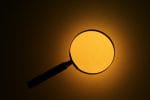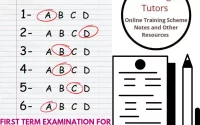Cultural and Creative Arts First Term Examination Questions JSS 3

FIRST TERM EXAMINATION
Subject: Creative and Cultural Arts
Class: JSS 3
Duration: 1 Hour 30 Minutes
Section A: Objective Questions (Answer all questions)
- Which of these art materials is in one colour?
a) Colour
b) Crayon
c) Charcoal
d) Chalk - Motif is _______
a) A unit or singular part of a design
b) A dominant theme in art
c) The main colour used in textile
d) Harmony - The most important function of a poster is to _______
a) Show a picture on a board
b) Show directional signs
c) Communicate some information to the public
d) Advertise shoes and bags - Pots are fired in _______
a) An oven
b) A furnace
c) A kiln
d) The kitchen - Which of these elements of art stimulates the sense of touch?
a) Line
b) Colour
c) Form
d) Texture - Drama is a part of performing art that deals with _______
a) Sound and body movement
b) Sleeping and performing
c) Drumming and dancing
d) Drawing and painting - The following are materials for crocheting EXCEPT _______
a) Ball of wool
b) A tape measure
c) Crochet hook
d) Caustic soda - Another name for abstract art is _______
a) Regular shapes
b) Non-representational shapes
c) Geometric shapes
d) Non-figurative shapes - The painting of sea and ocean is known as _______
a) Landscape
b) Ocean scape
c) Seascape
d) River scape - Another name for calligraphy is _______
a) Typeface
b) Pen lettering
c) Handwriting
d) Hieroglyphics - What category of people is called artists?
a) Everybody
b) Painters and sculptors
c) Nobody at all
d) Creative writers only - The letters that represent the musical note are _______
a) First 10 letters
b) First 4 letters
c) First 7 letters
d) First 12 letters - A branch of art connected with appealing to man’s sense of beauty and emotion is _______
a) Graphic art
b) Applied art
c) Fine art
d) Literary art - The following are examples of craft products EXCEPT _______
a) Embroidery
b) Drawing
c) Basket
d) Cane chair - A large hall where artworks are displayed and sold to the public is called _______
a) Studio
b) Museum
c) Gallery
d) Market - Educative is one of the functions of _______
a) Drama
b) Music
c) Drawing
d) Dance - The study of cultural and creative art deals with _______
a) Animals
b) Teaching
c) Painting
d) Humans - The early man wrote and drew on _______
a) His palm
b) Paper
c) Outside his cave
d) The wall of his cave - Letters can be classified into _______
a) Roman and Gothic
b) Egyptian and Roman
c) Block and Script
d) Cap and Low - Both capital and small letters are otherwise known as _______ respectively.
a) Long and short case
b) Oriental and continental
c) Upper and lower case
d) Bold and narrow - Good spelling is essential in lettering for _______
a) Structural design
b) Economy of paper
c) Judicious use of space
d) Legibility - The oldest cultural art in Nigeria is _______
a) Nok
b) Benin
c) Ife
d) Igbo-Ukwu - The method by which fabric is decorated with thread is _______
a) Stitches
b) Knitting
c) Embroidery
d) Macramé - Which of the following is an example of complementary colour?
a) Blue and Purple
b) Yellow and Purple
c) Red and Yellow
d) Red and Purple - A drawing where a human poses for an artist is called _______ drawing
a) Nature
b) Posing
c) Life
d) Still Life - Watercolour painting is best rendered with _______
a) Marker
b) Sable brush
c) Painting brush
d) Bristle brush - If one primary colour is mixed with one secondary colour, it forms _______ colour
a) Triad
b) Tertiary
c) Complementary
d) Monochrome - Which material is best for painting?
a) Clay
b) Water
c) Oil
d) Colour - _______ lettering is drawn or constructed.
a) Pen lettering
b) Script lettering
c) Block lettering
d) Constructed lettering - The drawing of household utensils is called _______
a) General drawing
b) Still Life drawing
c) Nature drawing
d) Life drawing - The arrangement of colours on a chart is called _______
a) Colour wheel
b) Format
c) Shapes of colour
d) Sphere - Embroidery is made on _______
a) Drawing board
b) Leather
c) Canvas
d) Cloth - The symbol of Sango deity is identified with _______
a) Cutlass
b) Hammer
c) Axe
d) Rod - An artist who models an object or carves wood is called a _______
a) Curator
b) Sculptor
c) Module
d) Carpenter - An object placed in a way to see the top is _______
a) Below the eye level
b) On the eye level
c) Beside the eye level
d) Above the eye level - Reading, movement, acting, and expression are activities involved in _______
a) Playing
b) Rehearsal
c) Singing
d) Drama - Which of the following is not a painter’s tool?
a) Brush
b) Palette
c) Colour
d) Squeegee - Which of the following is associated with batik?
a) Developer
b) Tool
c) Thread
d) Wax - Papier Mâché is a medium for _______
a) Sculpture
b) Painting
c) Construction
d) Drama - Canvas is mostly used in _______
a) Textile
b) Ceramics
c) Sculpture
d) Painting - Soapstone carvings were discovered in _______
a) Ekoi and Esie
b) Ife and Benin
c) Ibadan and Ogoja
d) Lagos and Jos - Nature drawing refers to _______
a) Drawing of tables
b) Drawing of land
c) Plant and animal drawing
d) Person drawing - The art of modeling and carving is known as _______
a) Graphics
b) Ceramics
c) Drawing
d) Sculpture - _______ is used to preserve wet clay.
a) Basket
b) Plate
c) Polythene
d) Paper - Clay is to sculpture as chisel is to _______
a) Drawing
b) Sculpture
c) Painting
d) Drama - _______ and _______ are the main types of perspective.
a) Linear and Upper
b) Angular and Parallel
c) Linear and Aerial
d) Angular and Horizontal - Carving involves _______
a) Adding
b) Chipping and adding
c) Subtracting
d) None of the above - The pre-historic people lived in _______
a) Houses
b) Stores
c) Huts
d) Caves - The word “craft” simply means _______
a) Portrait
b) Handwork
c) Machine product
d) Industrial arts - Ife art culture is located in _______
a) Oyo State
b) Osun State
c) Ogun State
d) Ibadan - Aina Onabolu was born in _______
a) 1890
b) 1882
c) 1950
d) 1960 - The earliest form of music was _______
a) Nature-based
b) Drum-based
c) Sound-based
d) Recorded - Theatre design is otherwise known as _______
a) Beauty design
b) Photo design
c) Scenography
d) Play design - One of the major types of African musical instruments is _______
a) Strings
b) Strings and woodwind
c) Metal drum
d) Bamboo drum - Visual Art relates to _______
a) Sound
b) Space
c) Image
d) Act - Which of these refers to dance drama?
a) Pure acting
b) Symbolism with movement
c) Design drama
d) Mixed drama - Textile printing requires _______
a) Patterns
b) Machines only
c) Symbols only
d) Tools only - Art Galleries show _______
a) Finished work
b) Drafts only
c) Unfinished art
d) Materials only - The background of a picture depicts _______
a) The focal point
b) The key feature
c) Support setting
d) Location - Ceramics refers to works made with _______
a) Clay
b) Cement
c) Powder
d) Glass
